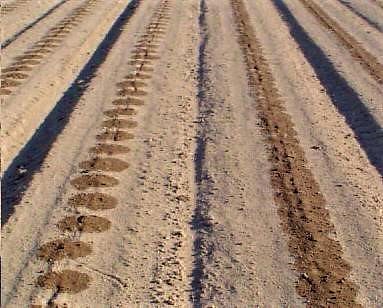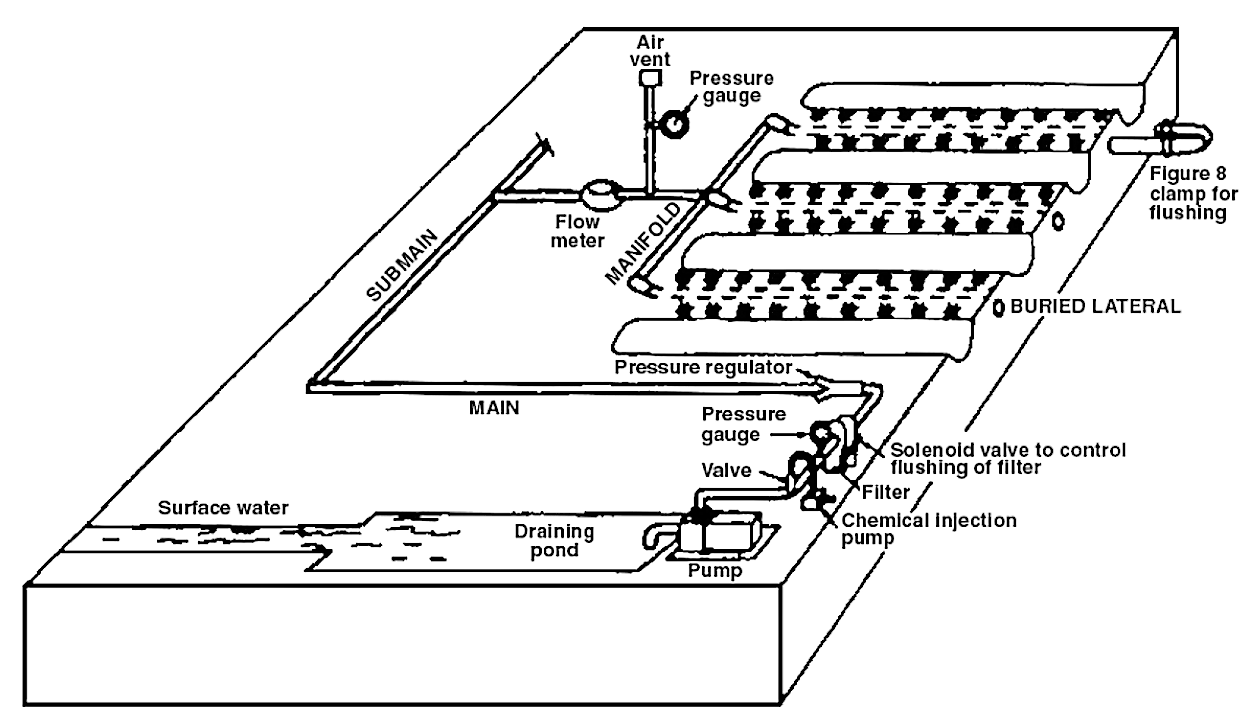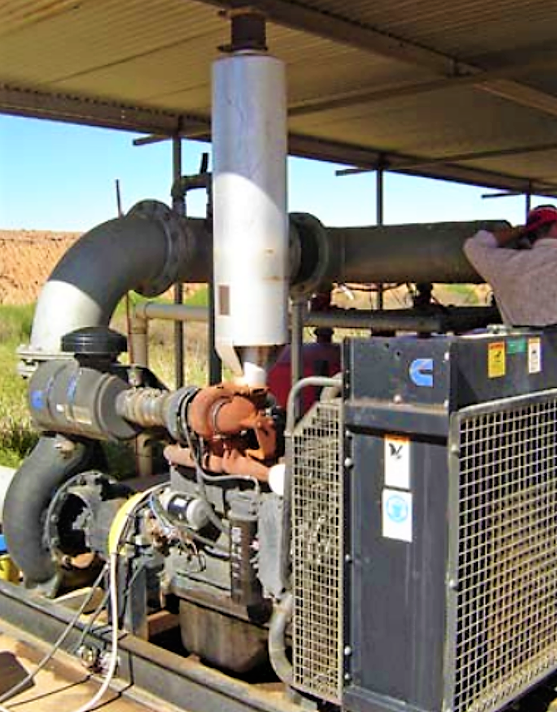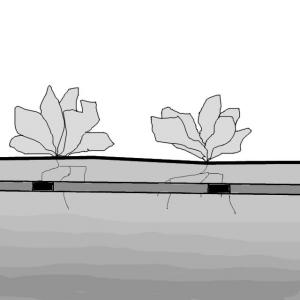Subsurface drip irrigation is a variation from conventional surface drip irrigation techniques. By minimising evaporation it uses water more efficiently than surface irrigation. The depth that the laterals (also used in conventional drip irrigation) are buried at depends mostly on the tillage practices and the crop to be irrigated. It is a costly system that needs expert design and maintenance. But it is also a very effective method that transports the water directly to the roots and is especially appropriate for arid and windy locations. Before entering the distribution pipes the water is filtered to minimise the risk of clogging. Still, the system must be designed so that all pipes can be flushed periodically. As it requires high maintenance and expert design, subsurface drip irrigation systems are more suitable for medium and large-scale production.
| In | Out |
|---|---|
Food Products |

Subsurface drip is a highly efficient irrigation system that uses buried drip tubes or drip tape to meet crop water needs. Since the water is applied below the soil surface (as opposed to surface irrigation or traditional drip irrigation), the effects of surface infiltration, such as crusting, saturated condition of ponding water, and water losses via evaporation and surface runoff (including soil erosion) are eliminated. With an appropriately sized and well-maintained subsurface drip irrigation system, water application is highly efficient and uniform.
Wetting occurs around the tube and water moves out in all directions. Moreover, water is applied directly to the root zone of the crop as opposed to the soil surface where most weed seeds hibernate. As a result, germination of annual weed is reduced. This lowers the pressure on valuable crops. Furthermore, some crops may benefit from the additional heat provided by dry surface conditions, and produce more biomass. When managed properly the application of fertiliser can be optimised. Fields can still be worked when irrigation systems are installed.
A subsurface drip irrigation system has a similar design as a common drip irrigation system. A typical system layout consists of a settling pond (where possible), pumping unit, pressure relief valve, check valve or back flow prevention valves, hydrocyclone separator (if a settling pond is not feasible), chemical/fertiliser injection unit (see also fertigation and nutrient requirements), filtration unit equipped with back flush valves, pressure regulators, air vent valves and PVC pipes delivering the water to the crop. The piping is 10 to 60 cm below the ground, depending on crop and soil (capillary attraction). As a water source, treated greywater or even blackwater is possible, with the risk of clogging being greater if the influent flow has not properly settled. Therefore, treatment of the water (e.g. a non-planted filter system, constructed wetlands (horizontal flow or vertical flow) or at least a septic tank) before the settling pond is necessary.

Subsurface drip irrigation is generally a high-tech, automatically operated technology applied to medium and large scale production (see also automatic irrigation). However, several low-cost and simple methods of subsurface (drip) irrigation like pitcher or bottle irrigation (see manual irrigation) exist that are equally effective for small-scale farming. There are several subsurface techniques used for secondary wastewater treatment such as leach field or evapotranspiration bed that also provide uncontrolled irrigation to fields.
REICH et al. (2009) estimates that investment costs of a subsurface drip irrigation system are high (1000 to 2000 US$ per acre). The costs vary depending on water source, quality, filtration needs, choice of material, soil characteristics and degree of automation (see also automatic irrigation). Normal life expectancy is between 12 and 15 years. With good maintenance and high water quality the system can be used even longer.
The performance and life of any system depends on how well it is designed, operated and maintained. It should either be automatically controlled or regularly inspected. Repairing the buried pipes is difficult, cumbersome and time-consuming. To prevent rodents from chewing the pipes, precautionary measures should be undertaken. The mechanical components such as pumps, valves and filters need to be maintained as well as checked and cleaned regularly.

The filter system of a large-scale subsurface drip irrigation facility is complex and its proper functioning is crucial to the whole system. The maintenance of the three main filters of the system (this contains centrifugal separators, screen and disk filters as well as sand media filters) should be carried out carefully (e.g. backwashing of sand media filter). Systems must be designed so that mainlines, sub-mains, manifolds and laterals can all be flushed. Mainlines, sub-mains and manifolds are flushed with a valve installed at the very end of each line. Lateral lines can be flushed manually or automatically. It is important to flush the lines at least every 2 weeks during the growing season (ENCISO et al. 2010).
(Adapted from TILLEY et al. 2014)
If wastewater that is not properly pre-treated (i.e. inadequate pathogen reduction) is used for irrigation health risks may arise. Appropriate pre-treatment should precede any irrigation scheme to limit health risks for those coming into contact with the water (see also waterborne diseases pathogens and contaminants). However health risks stemming from subsurface drip irrigation are considerably reduced because the irrigation water is discharged into the root zone and direct contact with crops and labourers is thus prevented.
Moreover, chemicals that are introduced into the system may contaminate the water. When effluent is used for irrigation, households and industries connected to the system should be made aware of the products that are not appropriate for discharging into the system (see also water pollution).
| Working Principle | Subsurface drip is a highly efficient drip irrigation system that uses buried drip tubes to discharge irrigation water directly at the roots. |
| Capacity/Adequacy | It is applicable to almost every crop, especially in arid areas. As it is rather high-tech it is more suitable for medium to large-scale production. |
| Performance | High |
| Costs | High |
| Self-help Compatibility | Due to its high-tech components it needs expert design and trained employees. |
| O&M | The maintenance of the subsurface piping system is time-consuming. |
| Reliability | Very reliable if operated and maintained well. |
| Main strength | High degree of control over water application with the potential for high uniformity of application. |
| Main weakness | Plugging and leakages can cause a lot of repair work. When saline water is used, salts accumulate at the wetting front. |
Subsurface drip irrigation systems are highly efficient irrigation systems that apply accurate amounts of water directly to the root zone, preventing water loss through evaporation and other negative effects of surface irrigation. This is especially suitable for arid, semi-arid, hot, and windy areas with limited water supply. However, as the system is relatively complex and most likely automated, it is more suitable for medium to large-scale production.
Healthy Soil Case Study. Sub-Surface Drip Irrigation
This is an article about the efforts of an Australian pioneer of sub-surface drip irrigation and his ideas and solutions.
CRC (n.y): Healthy Soil Case Study. Sub-Surface Drip Irrigation. Narrabri: Cotton Catchment Communities. [Accessed: 24.06.2011] PDFMaintaining Subsurface Drip Irrigation Systems
Subsurface Drip Irrigation (SDI)
This paper gives a complete description of a subsurface irrigation system.
REICH, D. GODIN, R. CHAVEZ, J.L. BRONER, I. (2009): Subsurface Drip Irrigation (SDI). Fort Collins: Colorado State University URL [Accessed: 08.05.2019]Filter Backwashing
Drip Irrigation Systems
Compendium of Sanitation Systems and Technologies
This compendium gives a systematic overview on different sanitation systems and technologies and describes a wide range of available low-cost sanitation technologies.
TILLEY, E. LUETHI, C. MOREL, A. ZURBRUEGG, C. SCHERTENLEIB, R. (2008): Compendium of Sanitation Systems and Technologies. Duebendorf, Switzerland: Swiss Federal Institute of Aquatic Science and Technology (EAWAG) and Water Supply and Sanitation Collaborative Council (WSSCC) URL [Accessed: 15.02.2010] PDFHealthy Soil Case Study. Sub-Surface Drip Irrigation
This is an article about the efforts of an Australian pioneer of sub-surface drip irrigation and his ideas and solutions.
CRC (n.y): Healthy Soil Case Study. Sub-Surface Drip Irrigation. Narrabri: Cotton Catchment Communities. [Accessed: 24.06.2011] PDFSmall-scale Irrigation for Arid Zones. Principles and Options
This publication is an attempt to distil current information on irrigation methods that might be appropriate, and to offer some ideas on the possible adoption and adaptation of such methods by small-scale farmers in the semi-arid areas of sub-Saharan Africa.
FAO (1997): Small-scale Irrigation for Arid Zones. Principles and Options. Rom: Food and Agriculture Organisation of the United Nations (FAO) URL [Accessed: 23.06.2011]Subsurface Irrigation. Fact vs. Fiction
This paper helps to understand that the relationship between soil, water and plants is the first and most critical step in knowing how to design a water efficient irrigation system.
NETAFIM (2009): Subsurface Irrigation. Fact vs. Fiction. Fresno: NETAFIM URL [Accessed: 24.06.2011]Subsurface irrigation. Factsheet
Subsurface Drip Irrigation (SDI)
This paper gives a complete description of a subsurface irrigation system.
REICH, D. GODIN, R. CHAVEZ, J.L. BRONER, I. (2009): Subsurface Drip Irrigation (SDI). Fort Collins: Colorado State University URL [Accessed: 08.05.2019]Water Saving and Yield Increase of Sugar Beet with Subsurface Drip Irrigation
This paper describes the subsurface drip irrigation technique in order to save water and increase the yield.
SAKELLARIOU-MAKRANTONAKI, M. ; KALFOUNTZOS, D. ; VYRLAS, P. (2002): Water Saving and Yield Increase of Sugar Beet with Subsurface Drip Irrigation. In: Global Nest: the International Journal: Volume 4 , 85 -91.Drip Irrigation Options for Smallholder Farmers in Eastern and Southern Africa
Smallholder farmers in the semi-arid regions of eastern and southern Africa have to depend on erratic, unreliable and low rainfall for their livelihoods. Subsistence staple food crops are generally grown under rainfed conditions. Consequently there is a growing interest in complementing this risky rainfed food production with cultivation of high-value vegetable crops and fruits. But in most cases this means these small-scale vegetable gardens and orchards must be irrigated in order to assure an economic return. Drip irrigation methods minimize the non-productive water losses associated with conventional irrigation, e.g. from evaporation and soil runoff, and thus can make more efficient use of the already minimal water supplies in these arid areas. But until recently drip irrigation technology had been associated with costly investments available only to large commercial farmers. Now there is growing interest in the technique and many efforts are being made around the world to develop low-cost, simple, drip irrigation systems suitable for smallholder farmers. This handbook presents some of these drip irrigation options that can be promoted by extension officers in eastern and southern Africa. It describes the most interesting small-scale low-cost drip irrigation methods of which the author and the other contributors have practical experience. It also gives a brief overview of methods that have been used successfully in other parts of the world with details of how to obtain further information about them or order equipment.
SIJALI, I.V. (2001): Drip Irrigation Options for Smallholder Farmers in Eastern and Southern Africa. Stockholm: Sida's Regional Land Management Unit URL [Accessed: 29.02.2012]Irrigation Practice and Policy in the Lowlands of the Horn of Africa
The drought of 2011 and the famine that followed in politically instable Somalia highlighted the vulnerability of the lowlands of the Horn of Africa. It is a story revisited with high frequency – 2000, 2005, and 2008. Climate variability is easily mentioned as the main attributing factor. Clearly it is – but there is also extensive land use change, because of the widespread invasion of invasive species (prosopis in particular) and the decimation of natural wood stands for charcoal production (particularly in Somalia). 2011 was a crisis year – but even in a normal years food insecurity is common. In the Afar lowlands in Ethiopia food aid has become part of the livelihoods, with most of the people dependent on it – including reportedly middle class families. There is a growing realization that water resource development – appropriate to the context – has to have a place in addressing food insecurity in the Horn of Africa. This paper focuses on irrigation policy and practice in the arid lowlands of the Horn that have been hit hardest and most frequent in the drought episodes
ALEMEHAYU, T. DEMISSIE, A. LANGAN, S. EVERS, J. (2011): Irrigation Practice and Policy in the Lowlands of the Horn of Africa. Rome: Food and Agriculture Organization of the United Nations (FAO) URL [Accessed: 26.03.2012]Wastewater Irrigation and Health
This book is written for practitioners, researchers and graduate students in environmental and public health, sanitary and agricultural engineering, and wastewater irrigation management in developing countries. In particular, it should be useful for all those working to assess and mitigate health risks from the use of wastewater and faecal sludge in agriculture, under conditions where wastewater treatment is absent or inadequate to safeguard public health. In this respect, the book builds on and complements the international Guidelines for the Safe Use of Wastewater, Excreta and Greywater published in 2006 by the World Health Organization in collaboration with the Food and Agriculture Organization of the United Nations and the United Nations Environment Programme.
DRECHSEL, P. ; SCOTT, C.A. ; RASCHID-SALLY, L. ; REDWOOD, M. ; BAHRI, A. (2010): Wastewater Irrigation and Health. Assessing and Mitigating Risk in Low-Income Countries. London: Earthscan URL [Accessed: 07.05.2019]Drip Irrigation Controls Soil Salinity Under Row Crops
Keeping soil salinity low in the root zone is crucial to growers of salt-sensitive crops. This study investigated patterns of soil salinity under surface and subsurface drip irrigation. High soil salinity occurred midway between drip laterals for both irrigation methods and above the drip tape for subsurface drip irrigation. Rainfall leached the salts from the zones of high salinity for both irrigation methods.
HANSON, B.R. ; BENDIXEN, W.E. (1995): Drip Irrigation Controls Soil Salinity Under Row Crops. In: California Agriculture: URL [Accessed: 08.05.2019]Potential and Challenges in Up-scaling Micro-irrigation in India
This paper aims to fill a research gap in India by focusing on adoption patterns of micro irrigation and the economic impacts on farm households.This study is based on primary and secondary data collected from nine states. It seeks to establish a relationship between landholding size, area under micro-irrigation, and net benefits. Farmers' suggestions for making micro irrigation more accessible are also noted.
PALANISAMI, K. RAMAN, S. (2012): Potential and Challenges in Up-scaling Micro-irrigation in India. Experiences from Nine States . (= Water Policy Research Highlight , 20 ). Gujarat, India: IWMI-Tata Water Policy Program URL [Accessed: 15.01.2013]Subsurface Irrigation. Increased Yield, Quality and Water Use Efficiency of Alfalfa
The objectives of this project were to develop crop-specific guidelines for Best Management Practices of subsurface irrigation systems for alfalfa, including system design criteria, identifying optimal irrigation and fertigation practices, crop water use and soil salinity patterns under SDI systems and developing crop coefficients for use with standard state-provided reference evapotranspiration.
PHENE, C.J. (2004): Subsurface Irrigation. Increased Yield, Quality and Water Use Efficiency of Alfalfa. Fresno: NETAFIM URL [Accessed: 24.06.2011]Micro-irrigation Subsidies in Gujarat and Andhra Pradesh
Despite its proven benefits, micro-irrigation has been slow to realise its potential in India. Following the recommendations of the Micro-irrigation task force in 2004, a tiered set of subsidies was put into place for micro-irrigation. The models set up in Andhra Pradesh and Gujarat have been considered the most successful. This paper compares these two models using several parameters and comes up with a set of recommendations for replication elsewhere.
PULLABHOTLA, H.K. KUMAR, C. VERMA, S. (2009): Micro-irrigation Subsidies in Gujarat and Andhra Pradesh. Implications for market dynamics and growth. (= Water Policy Research Highlight , 43 ). Gujarat, India: IWMI-Tata Water Policy Program URL [Accessed: 15.01.2013]Subsurface Drip Irrigation (SDI) System Remediation - A Case Study
This paper reviews minimum design recommendations and a case study of remediation efforts on an existing commercial field.
ROGERS, D.H. LAMM, F.R. CLARK, G.A. (2004): Subsurface Drip Irrigation (SDI) System Remediation - A Case Study. St. Joseph: American Society of Agricultural and Biological Engineers URL [Accessed: 08.05.2019]Water Reuse
To meet the challenges extremely efficient water use is necessary to achieve overall improvements in water productivity. Multi-use systems will therefore be crucial in integrated water management. Different examples show how water can be reused and recycled and thus increasing water efficiency in urban, peri-urban and rural areas. Issue 11 of Sustainable Sanitation Practice (SSP) on „Water reuse“ shows 3 examples for the use of treated wastewater for irrigation in agriculture: (1.) The first paper presents results from a long-term study (agricultural wastewater reuse) carried out in Sicily, Italy. (2.) The second paper presents activities on water management in the Oasis of Figuig, Morocco. (3.) The third paper presents practical experiences from a feasibility study on technology selection for wastewater treatment and effluent reuse schemes in Anza village, Palestine.
MUELLEGGER, E. ; LANGERGRABER, G. (2012): Water Reuse. Vienna: EcoSan Club URL [Accessed: 18.07.2012]More Crop Per Drop
Simple low-cost drip irrigation is practical and affordable for smallholder farmers. It has been successfully used in India and is becoming more popular in other southeast Asia and sub-Saharan Africa. It can reduce both water and labor use by as much as 20-50%. Yield of vegetables also can be increased by at least 10%. Our farm trials in Cambodia showed yield increases of 20-50% compared to traditional hand watering. Low pressure irrigation is also a key component of the African Market Garden concept jointly developed in west Africa with ICRISAT. This 10-chapter drip irrigation manual provides basic, step-by-step procedures for installing simple drip irrigation systems for different crops, climates, and soils.
PALADA, M. BHATTARAI, S. WU, D. ROBERTS, M. BHATTARAI, M. KIMSAN, R. MIDMORE, D. (2011): More Crop Per Drop. Using Simple Drip Irrigation Systems for Small-scale Vegetable Production. Shanhua, Tainan: AVRDC - The World Vegetable Center URL [Accessed: 08.05.2019]Drip Irrigation Systems
This website contains a short description of drip irrigations systems.


